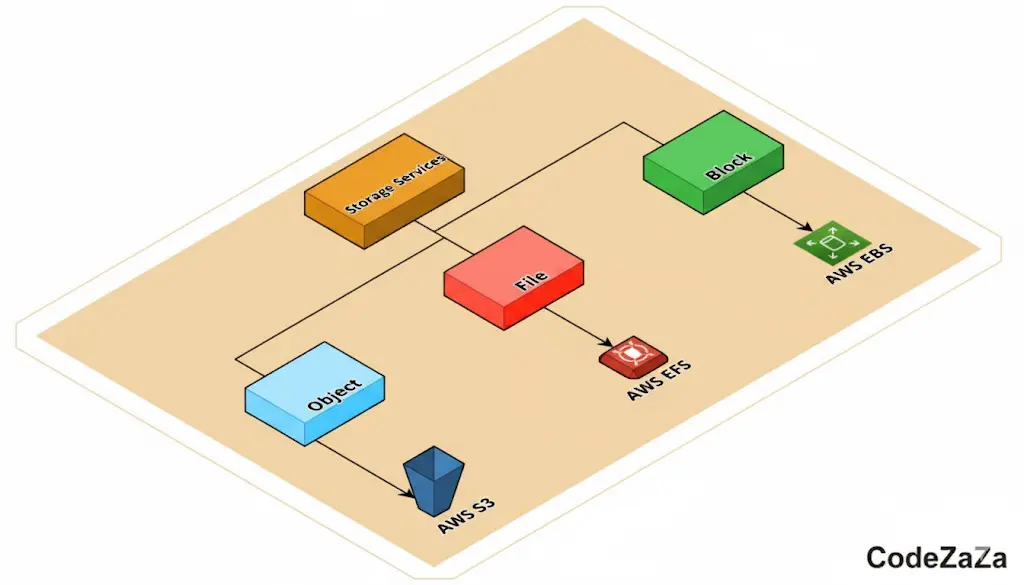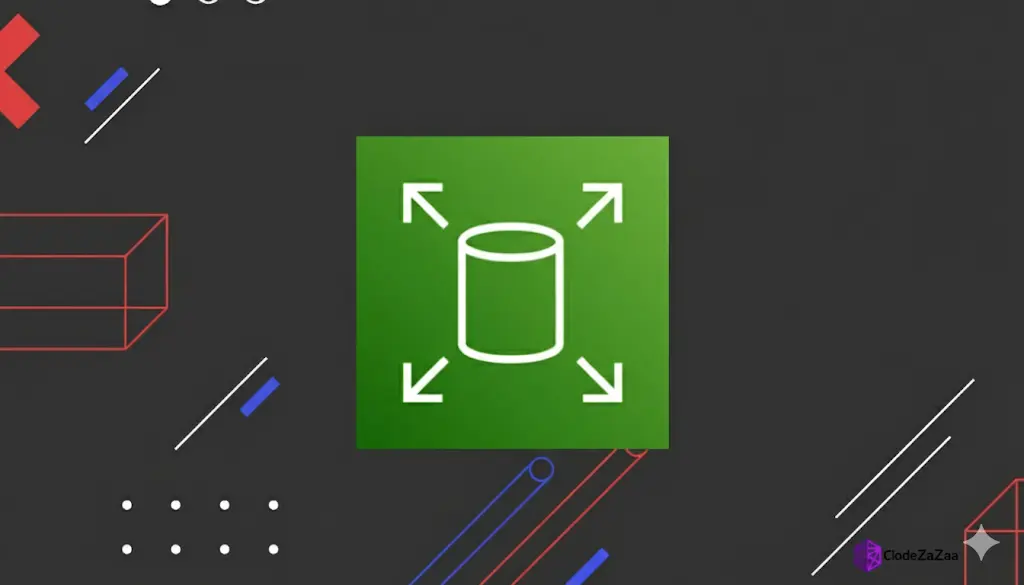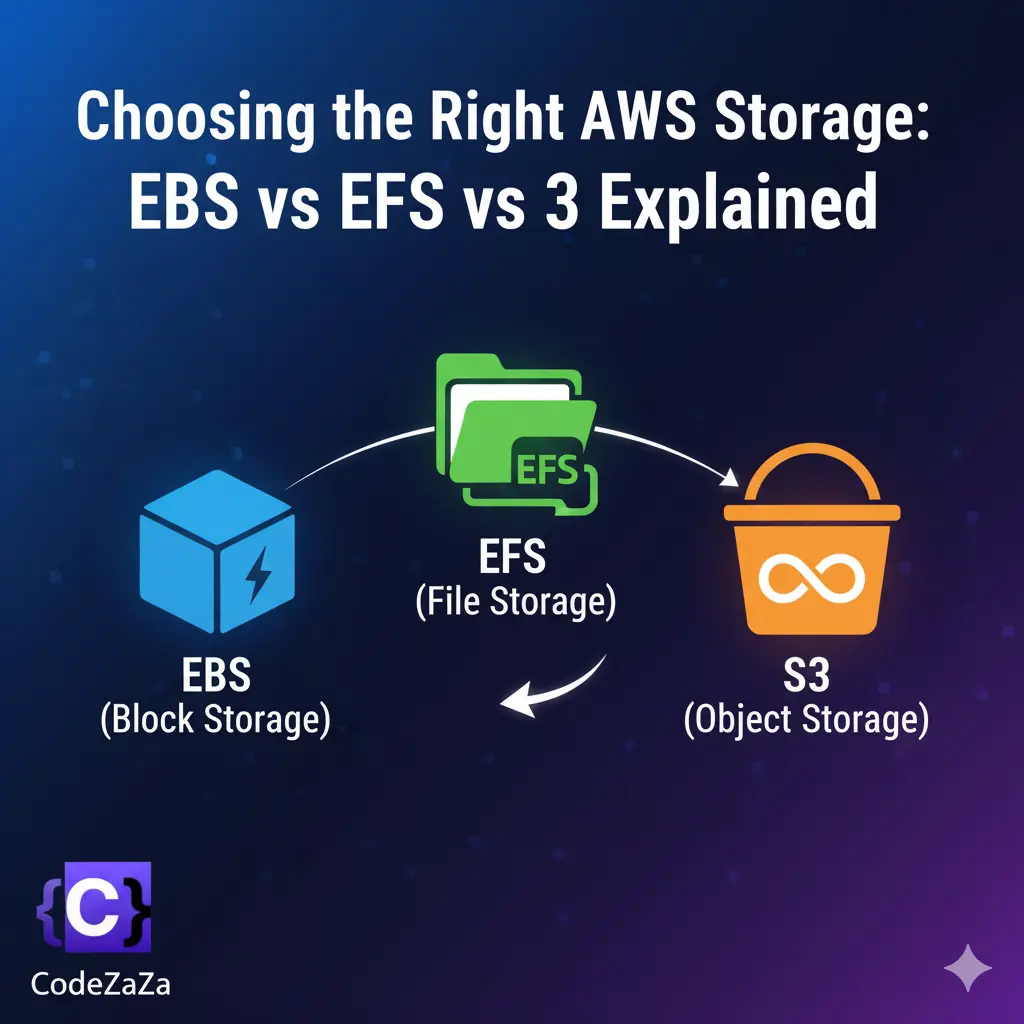AWS offers a variety of services, including storage solutions. Three popular options within its storage portfolio are EBS, EFS, and S3. Choosing the most suitable one for your business needs can be confusing. This blog aims to clarify the distinctions between these services. We’ll highlight their core functionalities and explain how each is designed for different objectives. By understanding your application’s workload, processing requirements, and computing needs, you can make an informed decision that keeps your overall cloud costs in check.
Understanding Storage Types

Before diving into the specifics of each AWS storage service, let’s establish a common ground by understanding the three primary storage types:
- Block Storage (AWS EBS): Imagine a traditional hard drive carved into individual, independent blocks. This is block storage, ideal for storing data accessed by a single instance, like operating systems or databases. It ensures high availability, critical for applications such as operating systems and databases, providing predictable I/O performance. Each block is addressed independently, allowing for fast and predictable I/O performance, critical for applications requiring low latency.
- File Storage (AWS EFS): Think of a network drive accessible by multiple users on a local network. File storage offers a hierarchical structure with folders and files, making it perfect for collaboration and application data. It includes a robust uptime guarantee, essential for shared application data and seamless collaboration. Users can navigate directories, share files, and collaborate seamlessly.
Object Storage (AWS S3): Picture a massive warehouse with individually labeled boxes. Each box is an object, and object storage treats data as unique entities. It guarantees high availability and uptime, making it ideal for storing large, unstructured datasets like backups and media archives.This approach is ideal for large, unstructured datasets like backups or media archives. Objects can be accessed individually without impacting others, making it highly scalable.
Their Strengths, Weaknesses, and Ideal Applications
Amazon EBS (Elastic Block Store)

Amazon Elastic Block Store (EBS) is often called the dependable knight of AWS storage. It provides high-performance block storage for Amazon EC2 instances, ensuring low latency and predictable performance. Because of its I/O throughput capabilities, EBS is well suited for mission-critical workloads such as databases and virtual desktops. However, since each volume can only attach to a single instance at a time, scaling requires provisioning additional EBS volumes.
Key Features
EBS offers several key features that make it an essential choice for many workloads. First, it provides persistent storage, meaning your data remains intact even after the termination of an EC2 instance. Second, it delivers high performance with low-latency and high-throughput capabilities, making it ideal for applications where speed and consistency are crucial. In addition, you can easily create snapshots for point-in-time backups, simplifying disaster recovery and data protection strategies. Finally, EBS supports multiple volume types, including both SSD and HDD options, so you can select the right balance of performance and cost for your application.
Use Cases
Amazon EBS shines in several practical scenarios. It is widely used for running databases that demand reliable and consistent storage performance. It also serves as boot volumes for EC2 instances, providing the operating system and application data. Developers often choose EBS for development and test environments, where persistent yet flexible storage is required. Furthermore, enterprise applications that rely on consistent and predictable performance benefit greatly from EBS volumes.
Limitations
Despite its strengths, EBS does come with a few limitations. The most notable is that each volume is attached to a single EC2 instance at a time, which can restrict sharing across multiple servers. Additionally, EBS volumes are tied to a specific Availability Zone, meaning they cannot be directly accessed across zones. Because of these constraints, scaling storage often involves provisioning additional volumes rather than automatically expanding capacity.
Amazon EFS (Elastic File System)

Amazon Elastic File System (EFS) is often called the adaptable ranger of AWS storage. It provides scalable file storage that multiple EC2 instances can access at the same time, making it ideal for distributed applications and content management systems. With EFS, teams can collaborate seamlessly because all files are stored in a central location. While it offers scalability and flexibility, its distributed nature means that performance may not always match the speed of dedicated block storage like EBS.
Key Features
EFS includes several features that make it stand out for shared workloads. Its elastic capacity allows the file system to automatically grow and shrink as you add or remove files, so there is no need for manual provisioning. With shared access, multiple EC2 instances can connect to the same file system simultaneously, ensuring smooth collaboration. It also provides consistent performance, supporting high throughput and IOPS for demanding workloads. Moreover, since EFS supports the NFSv4 protocol, it integrates easily with many existing applications and systems.
Use Cases
There are many situations where EFS is the right choice. It works well for content management systems, where multiple users need to store and retrieve files. It is also widely used for web serving, since applications can deliver content directly from the file system. For distributed applications, EFS simplifies data sharing by providing a common storage layer. In addition, big data analytics workloads benefit from its ability to handle large amounts of data with scalable performance.
Limitations
Even though EFS offers flexibility, there are some trade-offs to consider. It generally has higher latency than EBS, which can affect workloads that demand ultra-fast response times. In addition, EFS can be more expensive than EBS for certain use cases, especially when the storage requirement is predictable and performance needs are high. Therefore, understanding your workload is important before choosing EFS as your storage solution.
Amazon S3 (Simple Storage Service)

Amazon Simple Storage Service (S3) is the boundless explorer of AWS storage and the king of scalable object storage. It allows you to store and retrieve virtually unlimited amounts of data, making it one of the most widely used services in AWS. From backups and archives to hosting static websites, S3 adapts to almost any storage requirement. Thanks to its massively scalable architecture, you can store petabytes of data with exceptional durability. Moreover, it is highly cost-effective, which makes it especially useful for archiving or storing data that is not accessed frequently. However, because it is object-based storage, S3 may not be the best choice for applications that require constant modifications to data.
Key Features
S3 offers a wide range of features designed for flexibility and durability. It provides unlimited storage capacity, allowing you to scale effortlessly as your data grows. With 99.999999999% (11 nines) durability, your data remains safe and highly available across multiple Availability Zones. You can enable versioning to keep multiple versions of your objects, which helps protect against accidental deletions or overwrites. Additionally, lifecycle management allows you to automate the transition of data between storage classes, saving costs for infrequently accessed data. Finally, fine-grained access control ensures that you can manage permissions down to the object level, keeping your data secure.
Use Cases
Amazon S3 is versatile and fits a variety of scenarios. It is commonly used for backup and restore, giving organizations a reliable way to safeguard their data. It also supports data archiving, making it easy to store large amounts of historical data at a low cost. Developers often use S3 for static website hosting, since it can deliver content quickly and reliably. For mobile and web applications, S3 acts as a storage backend, managing files such as images, videos, and documents. In addition, it plays a critical role in big data analytics, where massive datasets need a durable and scalable storage solution.
Limitations
While S3 is extremely powerful, it does come with certain limitations. Because it is object-based storage, it is not suitable for workloads that behave like traditional file systems or databases. Applications that require low-latency access with frequent read and write operations may face performance issues. In such cases, block storage or file storage solutions like EBS or EFS might be more appropriate.
A Deep Dive into Functionality: A Feature Comparison Table
Here’s a comprehensive table that compares the key functionalities of EBS, EFS, and S3 to provide a clearer picture:
| Feature | EBS | EFS | S3 |
| Storage Type | Block | File | Object |
| Scalability | Limited (attached to single EC2 instance) | Highly Scalable (independent of instances) | Highly Scalable (massive data storage) |
| Performance | High (predictable I/O throughput) | Moderate (depends on network conditions) | Lower (object-based access, higher latency) |
| Typical Use Cases | Databases, Operating Systems, Mission-Critical Applications | Application Data, Shared Files, Content Management Systems | Backups, Archives, Static Website Content, Big Data Analytics |
| Durability | Very High (multiple availability zones) | Very High (multiple availability zones) | Very High (replication across regions) |
| Consistency | Strong (data consistency guaranteed) | Eventual (data consistency eventually achieved) | Eventual (data consistency eventually achieved) |
| Access Patterns | Random reads/writes (ideal for low latency) | Sequential/random reads, infrequent writes | Primarily reads, occasional writes |
| Pricing | Storage used per month + provisioned IOPS | Storage used per GB/month | Tiered storage pricing (storage used, data retrieval, data transfer out) |
The Pricing Landscape
While functionality and suitability for your use case are paramount, cost considerations play a crucial role in your AWS storage strategy. Let’s delve into the pricing structures of each service:
EBS: EBS pricing is a two-part equation: storage used per month and provisioned IOPS (Input/Output Operations Per Second). Storage costs are relatively straightforward; you pay for the amount of EBS storage you provision. However, IOPS determine the performance of your EBS volume. Higher IOPS translate to faster data transfer speeds, but they come at a premium. Finding the right balance between storage space and IOPS for your specific needs is key to optimizing costs.
| Service/Feature | Pricing Details |
| Volume Pricing | |
| General Purpose SSD (gp2) | $0.10 per GB-month of provisioned storage |
| Provisioned IOPS SSD (io2) | $0.125 per GB-month of provisioned storage$0.065 per provisioned IOPS-month |
| Cold HDD (sc1) | $0.025 per GB-month of provisioned storage |
| Snapshot Pricing | $0.05 per GB-month of data stored |
| Data Transfer | |
| Data Transfer within the same AWS Region | Free |
| Data Transfer to Internet | Standard EC2 data transfer rates apply |
EFS: EFS utilizes a simpler pay-per-use pricing model. You are charged only for the storage used per GB/month. This makes EFS highly cost-effective for frequently accessed files, as you only pay for what you use. However, consider factors like data transfer costs when accessing EFS volumes from multiple EC2 instances across different Availability Zones (AZs).
| Service/Feature | Pricing Details |
| Storage Pricing | |
| Standard Storage | $0.30 per GB-month of storage |
| Throughput Pricing | |
| Standard | $6.00 per MB/s-month |
| Request Pricing | |
| Requests | $0.01 per 1,000,000 requests |
Amazon S3 Pricing Overview
Amazon S3 follows a pay-as-you-go model where charges depend on storage, data retrieval, and data transfer out. Pricing also varies across different storage classes. Let’s break it down in detail
| Category | Details | Pricing |
|---|---|---|
| Storage | Standard (First 50 TB / Month) | $0.023 per GB |
| Standard (Next 450 TB / Month) | $0.022 per GB | |
| Standard (Over 500 TB / Month) | $0.021 per GB | |
| Infrequent Access (IA) | $0.0125 per GB-month | |
| Glacier | $0.004 per GB-month | |
| Glacier Deep Archive | $0.00099 per GB-month | |
| Data Transfer Out | First 1 GB / Month | Free |
| Up to 10 TB / Month | $0.09 per GB | |
| Next 40 TB / Month | $0.085 per GB | |
| Next 100 TB / Month | $0.07 per GB | |
| Over 150 TB / Month | $0.05 per GB | |
| Requests | PUT, COPY, POST, LIST | $0.005 per 1,000 requests |
| GET, SELECT, Other | $0.0004 per 1,000 requests |
Crafting Your Cloud Storage Strategy
Now that you understand the functionalities, strengths, weaknesses, and pricing structures of each AWS storage service, you can confidently start building a winning cloud storage strategy. Let’s break it down step by step.
Key Considerations for Choosing AWS Storage
When deciding between EBS, EFS, and S3, keep these factors in mind:
- Access Patterns:
- Frequent random reads/writes → Choose EBS for low latency.
- Sequential reads or occasional writes → Consider EFS.
- Read-heavy workloads with minimal modifications → S3 works best.
- Data Size and Scalability Needs:
- Small datasets (<1 TB) → EBS may suffice.
- Moderate datasets (1–100 TB) → EFS offers flexibility.
- Massive datasets (>100 TB) → S3 is built for scale.
- Performance Requirements:
- High I/O throughput → EBS is unmatched.
- Moderate performance → EFS works well.
- Latency-sensitive workloads → Avoid S3.
- Cost Constraints:
- Tight budget → Optimize with S3’s tiered pricing.
- Pay-per-use simplicity → EFS is ideal.
- Performance-driven → EBS is worth the investment.
Cloud Storage Needs Assessment Checklist
Use this quick checklist to evaluate your requirements:
- Data Patterns: Frequently updated / Occasionally updated / Rarely changed
- Data Size: Small (<1 TB) / Medium (1–100 TB) / Large (>100 TB)
- Growth Rate: Slow / Steady / Rapid
- Performance Needs: Very High / Moderate / Basic
- Budget Priority: Low cost / Performance / Balanced
- Access: Multiple locations / Single location / Both
- Main Concern: Security / Ease of use / Scalability / Cost efficiency
This checklist helps you reflect on both current and future needs so you can align with the right AWS storage service.
Interpreting the Checklist Results
- Amazon EBS → Best if you need frequent updates, low latency, and very high performance (e.g., databases, critical apps).
- Amazon S3 → Ideal for rarely updated, large datasets like backups, archives, or media storage.
- Amazon EFS → Suitable for shared access from multiple instances with moderate performance needs.
Tip: Many businesses end up with a hybrid solution that uses more than one storage service.
A Multi-Service Approach in Action
A practical strategy often combines all three services:
- Core Application → Use EBS for OS and database volumes.
- Shared Files → Store in EFS for team collaboration.
- Backups & Archives → Move to S3 for cost savings.
This approach leverages the strengths of each service to balance performance, scalability, and cost.
Conclusion
In summary, AWS EBS, EFS, and S3 offer diverse storage solutions tailored to varying business needs. Whether prioritizing high performance, scalability, or versatile object storage, understanding these options facilitates strategic decision-making for effective cloud storage management. Each service’s strengths in block, file, or object storage cater to specific application requirements, ensuring businesses can optimize their storage infrastructure efficiently within AWS’s ecosystem


